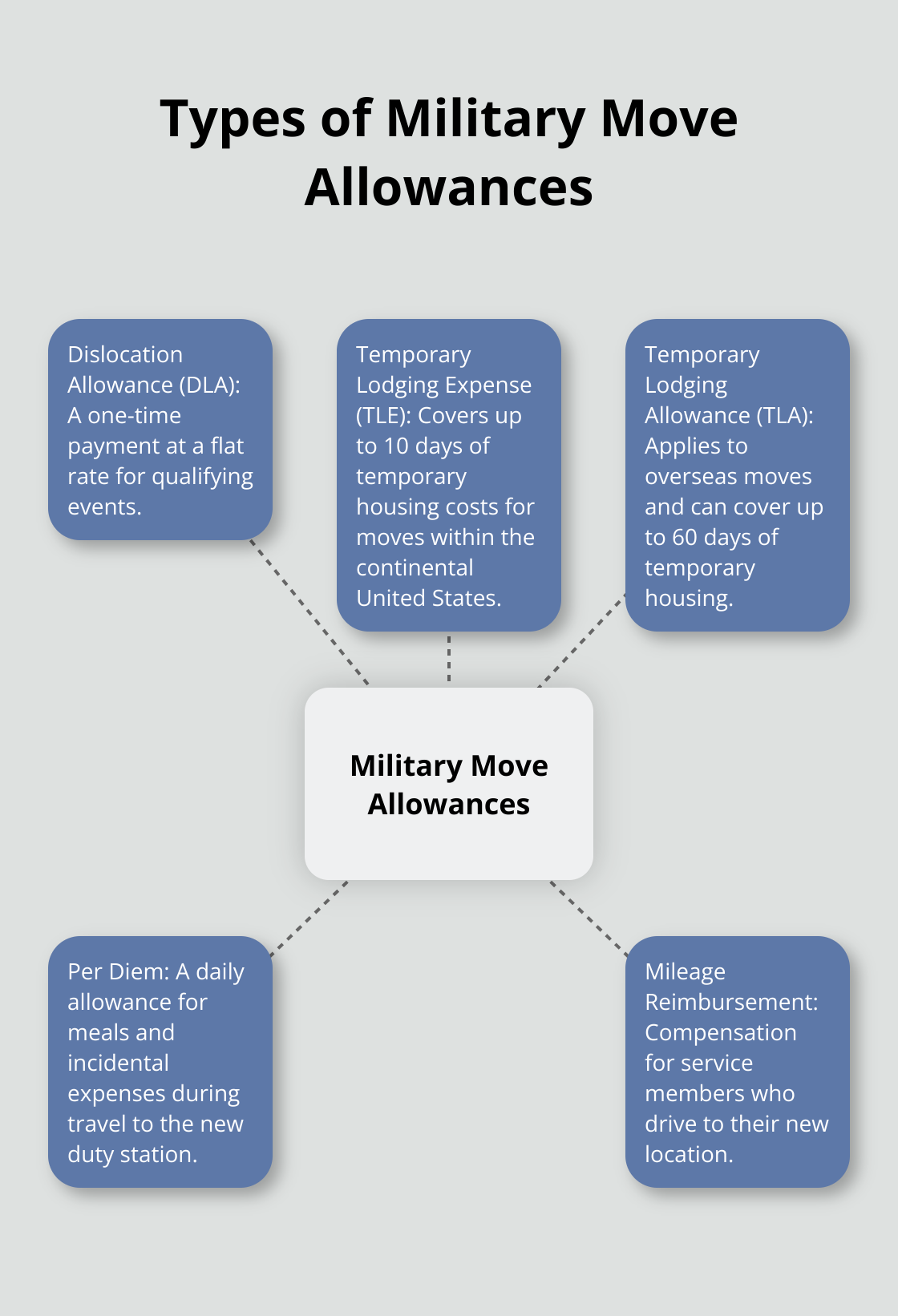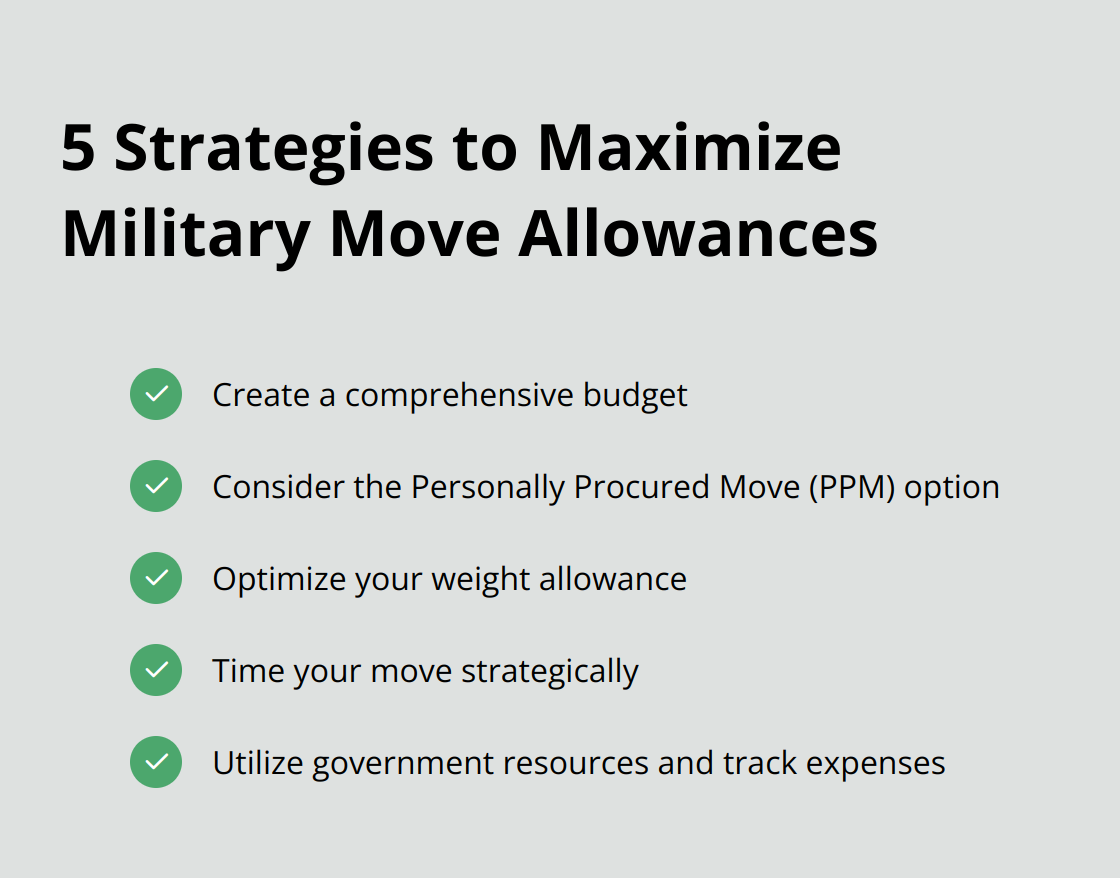Military move allowances can be a complex topic for service members and their families. At Southbay Moving Systems, we understand the challenges of navigating these financial benefits during a PCS (Permanent Change of Station).
This guide will break down the types of allowances, factors affecting their amounts, and strategies to maximize your benefits. We’ll also highlight common pitfalls to avoid, ensuring you’re well-prepared for your next military move.
What Are Military Move Allowances?
Types of Military Move Allowances
The Department of Defense provides several allowances to support service members during Permanent Change of Station (PCS) relocations. These financial benefits cover various aspects of the moving process:
- Dislocation Allowance (DLA): A one-time payment paid at a flat rate for a qualifying event.
- Temporary Lodging Expense (TLE): Covers up to 10 days of temporary housing costs for moves within the continental United States.
- Temporary Lodging Allowance (TLA): Applies to overseas moves and can cover up to 60 days of temporary housing.
- Per Diem: A daily allowance for meals and incidental expenses during travel to the new duty station.
- Mileage Reimbursement: Compensation for service members who drive to their new location.

Factors Influencing Allowance Amounts
Several factors determine the amount of allowances a service member receives:
- Rank: Higher-ranking service members typically receive larger allowances.
- Dependency Status: Those with dependents often qualify for higher allowance rates.
- Location: Allowances may vary based on the cost of living at the origin and destination.
- Distance: Longer moves usually result in higher allowances for transportation and related expenses.
- Housing Availability: Additional housing allowances may apply if government housing isn’t available at the new duty station.
Calculating Your Allowances
To determine your specific allowances, use the Defense Travel Management Office’s official PCS calculator. This tool provides personalized estimates based on your unique circumstances (rank, dependency status, and move details).
The military frequently updates allowance rates, so it’s important to verify current figures with your installation’s transportation office or the Defense Travel Management Office website. This step will help you plan and budget effectively for your upcoming PCS move.
Maximizing Your Allowances
To make the most of your military move allowances:
- Start planning early: Early preparation allows you to take advantage of all available benefits.
- Keep detailed records: Document all expenses related to your move (receipts, mileage logs, etc.).
- Understand weight limits: Know your authorized weight allowance and try to stay within it to avoid out-of-pocket expenses.
- Consider a Personally Procured Move (PPM): This option might allow you to pocket any savings from moving under the government’s cost estimate.
- Seek professional advice: Consult with your base’s relocation assistance program or a reputable moving company experienced in military relocations (such as Southbay Moving Systems).
Understanding these allowances forms the foundation for a successful military move. The next section will explore strategies to maximize these benefits and minimize out-of-pocket expenses during your PCS.
How to Maximize Your Military Move Allowance

Create a Comprehensive Budget
The foundation of maximizing your allowance is a detailed budget. List all anticipated expenses, from packing materials to temporary lodging. Compare this against your estimated allowances using the Defense Travel Management Office’s PCS calculator. This comparison will help you identify potential shortfalls and areas where you might need to adjust your spending.
Consider the Personally Procured Move (PPM) Option
Opt for a Personally Procured Move (formerly known as a DITY move). With a PPM, the government pays you 100% of what they would pay the military contractor. This option often results in significant savings, especially if you do some of the work yourself. However, you must weigh the potential savings against the time and effort required.
Optimize Your Weight Allowance
Your weight allowance is a critical factor in your move. Exceeding it can lead to hefty out-of-pocket expenses. Declutter and sell or donate items you no longer need. For items you’re unsure about, use vacuum storage bags to reduce volume and weight. If you’re close to your limit, it might be more cost-effective to ship some items separately or leave them in storage.
Time Your Move Strategically
If possible, schedule your move during the off-peak season (October to March). Moving companies often offer lower rates during these months, which can stretch your allowance further if you’re doing a PPM. Additionally, you may find better deals on temporary lodging during off-peak times.
Utilize Government Resources and Track Expenses
Take full advantage of the resources provided by the military. The Military OneSource website offers a wealth of information on PCS moves, including checklists and planning tools. Your base’s transportation office can provide guidance on local regulations and additional resources. Don’t hesitate to ask questions – these resources exist to help you navigate your move efficiently.
Keep meticulous records of all move-related expenses (receipts for packing materials, fuel costs, tolls, and any services you pay for out of pocket). Even small expenses can add up, and proper documentation ensures you can claim all eligible reimbursements. Try using a dedicated app or spreadsheet to track these expenses in real-time.
Look beyond the standard allowances. Depending on your situation, you might be eligible for additional benefits. For example, if you’re moving to an area with a higher cost of living, you may qualify for a Cost of Living Allowance (COLA). If you’re moving overseas, investigate the Overseas Housing Allowance (OHA) and other location-specific benefits.
These strategies can significantly stretch your military move allowance and reduce financial stress during your PCS. Each move is unique, so tailor these tips to your specific situation. While maximizing your allowances is important, it’s equally crucial to avoid common pitfalls that can derail your moving budget. Let’s explore these potential issues and how to steer clear of them in the next section.
Avoiding Common Military Move Pitfalls

Misinterpreting Allowance Limits
Military move allowances often confuse service members. Many assume the Dislocation Allowance (DLA) covers all moving expenses. In reality, DLA partially reimburses a service member for the expenses incurred in relocating the household on a Permanent Change of Station (PCS).
To prevent misunderstandings, review each allowance’s purpose and limitations. The Defense Travel Management Office website offers detailed breakdowns of each benefit. Your base’s transportation office can clarify any confusing points.
Neglecting Proper Documentation
Accurate record-keeping of moving expenses is essential. The Department of Defense allocates significant funds for PCS moves. However, many service members failed to claim all eligible reimbursements due to poor documentation.
Create a dedicated folder for all move-related receipts and documents. Use a smartphone app to scan and organize receipts immediately. Keep a detailed log of mileage if you drive to your new duty station. Small expenses like packing tape or bubble wrap can add up and may qualify for reimbursement.
Overlooking Lesser-Known Benefits
Service members often miss additional benefits due to lack of awareness. The Military Surface Deployment and Distribution Command’s “It’s Your Move” program provides up to $500 for service members who pack their own household goods.
Research thoroughly and consult your base’s relocation assistance program. They can inform you about location-specific benefits not found in general guides. Some overseas locations offer a Foreign Transfer Allowance to cover miscellaneous expenses related to international moves.
Underestimating Weight Limits
Service members frequently exceed their authorized weight allowance, resulting in out-of-pocket expenses. The government sets weight limits based on rank and dependency status.
Conduct a thorough inventory before your move. Sell, donate, or discard items you no longer need. Consider shipping some items separately or leaving them in storage if you’re close to your limit. Accurate weight estimation can save you from unexpected costs.
Ignoring Timing Considerations
The timing of your move can significantly impact your expenses. Peak moving season (May to August) often means higher costs and limited availability.
Try to schedule your move during off-peak seasons if possible. This strategy can lead to better rates and more flexible scheduling options. If you must move during peak season, book your move as early as possible to secure the best rates and services.
Final Thoughts
Military move allowances require careful planning and research to maximize benefits and minimize expenses. Service members must understand allowance types, influencing factors, and calculation methods for a successful PCS move. Strategies like budgeting, considering a Personally Procured Move, and optimizing weight allowances can help stretch allowances further.
Avoiding common pitfalls is essential for a smooth transition. Service members should interpret allowance limits correctly, maintain proper documentation, and explore lesser-known benefits. They must also estimate weight limits accurately and consider move timing to prevent unnecessary stress and financial strain.
Southbay Moving Systems offers specialized services for military relocations, providing expert guidance throughout the moving process. With their experience in handling military moves, they can assist service members in navigating the complexities of military move allowances (including weight restrictions and reimbursement procedures). Each PCS move presents unique challenges, so staying informed about the latest regulations and benefits will help service members manage their relocations with confidence and financial savvy.




